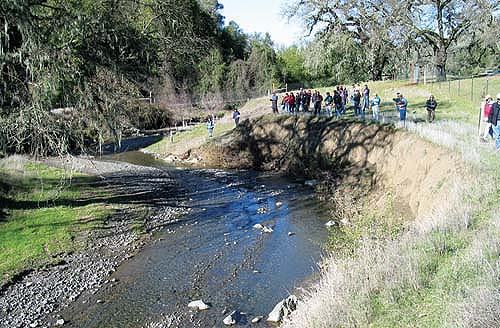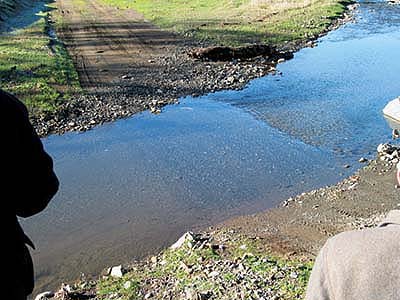All Issues
Courses help ranchers, farmers mitigate water-quality impacts
Publication Information
California Agriculture 58(3):134-135.
Published July 01, 2004
PDF | Citation | Permissions
Full text
Water-quality short course participants evaluate a sediment source site (bank-cutting) along Parson's Creek using the Sediment Inventory Method, at the UC Hopland Research and Extension Center in Mendocino County.
Most of the water-quality problems in the United States are from runoff, and in many places much of this nonpoint source pollution in rivers and lakes comes from agriculture, according to the U.S. Environmental Protection Agency (EPA). Ranching and farming practices can degrade streams and coastal waters with nonpoint source pollutants such as sediment, heat and nutrients ( see pages 138 to 163). This degradation can threaten salmon, which need cold, clear water for spawning.
In 1989, the range livestock industry recognized that it needed to address water quality and asked UC for help. “The industry knew regulation was coming,” says Melvin George, UC Cooperative Extension (UCCE) rangeland management specialist.
In 1994, the UCCE Rangeland Watershed Program began working with ranchers and state agencies to develop the Ranch Water Quality Management Planning Shortcourse, which helps ranchers develop voluntary plans for managing water quality on their land. “The beauty of it is that landowners can make their own decisions so they don't have a regulatory agency come and tell them what to do,” says George, who helped develop the short course.
Landowners in watersheds with rivers listed as impaired by the EPA must help meet total maximum daily load (TMDL) regulations, which stipulate how much pollution bodies of water can receive and still meet water-quality standards.
The ranch water-quality short course entails about 10 to 15 hours of classroom and field instruction, including clean water laws; monitoring pollution sources; and management of nonpoint source pollution, such as sediment from cattle grazing and trampling, heat from decreased riparian vegetation, and nutrients and pathogens from manure. The short course culminates in developing individualized ranch water-quality management plans that identify and prioritize water-quality problems and outline how to address them.
The short course has had more than 60 sessions attended by more than 800 ranchers from 31 counties, and by mid-2004 had resulted in plans covering 1.3 million acres of rangeland. A 2002 survey of participants showed that 60% had completed a plan in class and 67% had implemented at least one of the recommended practices for protecting water quality. These practices include installing fences to exclude cattle from riparian areas; revegetating riparian areas; and slowing down the movement of water along and across dirt roads, which are a major source of sediment on slopes. “We proved that a voluntary program can work,” George says.
The short course also encourages landowners to form watershed management groups. “Nonpoint source pollution is not an individual problem, it's a watershed problem. If everyone gets together, they can have an effect,” George says. Course participants have formed watershed groups in counties including Humboldt, Mendocino and Monterey. Other benefits of forming such groups are that they are more likely to get water-quality grants and can streamline permitting for watershed activities such as modifying streambeds.
A similar course for Central Coast farmers was patterned on the successful ranch course a few years ago, spearheaded by UCCE farm advisor Mary Bianchi. Unlike many other irrigated agricultural areas in California, many Central Coast farms are on slopes that are susceptible to erosion. Moreover, these watersheds drain into Monterey and Morro Bay estuaries or into rivers where salmon spawn.
This new course for farmers may be particularly relevant to growers in coming years. While agricultural discharges in California have historically been exempt from water-quality regulations, the State Water Resources Control Board recently began developing a compliance process for growers who discharge irrigation return water. The process would include monitoring and management measures to protect downstream water resources.
Like the ranch short course, the Farm Water Quality Management Planning Shortcourse culminates in developing a water-quality management plan that addresses farm nonpoint source pollution such as sediment, nutrients and pesticides. The short course is now offered in all seven Central Coast counties from San Mateo to Santa Barbara, and already 16% of the Central Coast producers have participated (about 400 out of 2,500). The course is offered in both English and Spanish, and binder materials will soon be available in Spanish.
“[The short course] encourages growers to complete conservation plans that integrate their production goals and management practices with water quality, habitat conservation and soil conservation goals,” says Julie Fallon, representative for the UCCE Farm Water Quality Planning Program.






